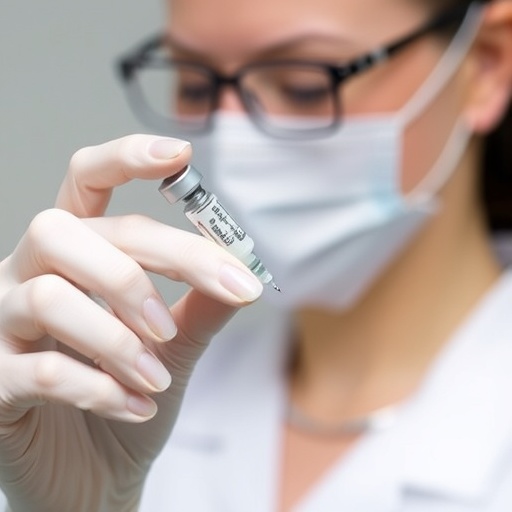A Breakthrough in Cervical Cancer Treatment: A Nasal Vaccine Shows Promising Results
Cervical cancer remains a significant health challenge worldwide, ranking among the most common cancers affecting women. Primarily caused by persistent infection with high-risk human papillomavirus (HPV) strains, particularly HPV16, this malignancy often demands aggressive treatments such as surgery, radiotherapy, or chemotherapy. Unfortunately, therapeutic options targeting existing HPV infections or HPV-associated cancers have been limited, with no approved medicinal treatments effectively addressing the viral cause or the tumors it induces. Advances in vaccine technology, however, are now paving the way for revolutionary therapeutic strategies, with a novel approach emerging from Chiba University, Japan.
Researchers at Chiba University have developed an intranasal therapeutic vaccine designed to combat HPV infections and hinder the progression of cervical cancer. This innovative nasal vaccine represents a paradigm shift, moving beyond traditional injectable vaccines and invasive treatment modalities. Delivered through the nasal mucosa, the vaccine initiates immune responses locally at mucosal surfaces, which serve as critical protective barriers in the body. Importantly, the nasal route mobilizes immune defenses not only in the upper airway but also in distant mucosal sites such as the female reproductive tract, targeting the cervical region vulnerable to HPV infection.
The groundbreaking study, spearheaded by Associate Professor Rika Nakahashi-Ouchida and her team, demonstrates the nasal vaccine’s ability to stimulate robust and sustained immune activity against HPV in preclinical models. The researchers capitalized on prior insights showing that nasal immunization could elicit strong antigen-specific T-cell responses in the vaginal mucosa against viruses like herpes simplex virus type 2 (HSV-2). Their approach involved leveraging cationic cholesteryl group-bearing pullulan (cCHP) nanogels as an antigen delivery vehicle. These nanogels, possessing a positive charge, adhere effectively to the negatively charged nasal mucosal surfaces, facilitating sustained release and uptake of HPV antigens.
Focusing on the E7 oncoprotein, a pivotal molecule produced by HPV16 that disrupts cellular tumor suppressive functions, the vaccine was engineered to induce a potent T-cell-mediated immune attack against cells expressing this viral antigen. The inclusion of the cyclic-di-adenosine monophosphate (c-di-AMP) adjuvant further enhanced the vaccine’s immunogenicity by activating pathways that promote helper and cytotoxic T cell responses, vital for recognizing and eradicating HPV-infected or cancerous cells.
Experimental evaluations in murine models yielded compelling results, with vaccinated mice exhibiting significant tumor growth retardation compared to controls. The team extended these findings to non-human primates, administering the formulation through a clinically applicable nasal spray device. Macaques receiving four doses developed high titers of E7-specific CD4+ helper and CD8+ cytotoxic T cells, which produced key cytokines linked to tumor suppression. Crucially, these antigen-specific immune cells homed to cervical tissues, confirming effective trafficking and local immune activation where the cancer develops.
Notably, the durability of the immune response is an essential feature of this vaccine. Immune surveillance remained robust even four months after the final immunization, suggesting the potential for long-term protection against HPV-driven cervical malignancies. Such persistent immunity is critical for preventing tumor recurrence and encouraging the clearance of HPV-infected cells, which are often resilient to immune attack.
The potential impact of this vaccine extends beyond its therapeutic promise. In addition to being non-invasive, the nasal delivery mechanism offers a fertility-preserving alternative to surgical interventions, addressing a significant concern among patients who desire future pregnancies. This innovation could transform cervical cancer management by shifting the treatment paradigm towards immunotherapy-based modalities that preserve quality of life and reduce treatment-associated morbidities.
Moreover, the cCHP nanogel platform developed for this vaccine holds promise as a versatile vector for other mucosal vaccines targeting diverse pathogens. Its ability to provide sustained antigen release and to effectively stimulate mucosal immunity opens avenues for broad clinical applications in infectious diseases and potentially beyond, including chronic inflammatory and autoimmune conditions.
World Health Organization data underscores the urgency of improved treatments for cervical cancer, which accounted for an estimated 660,000 new cases and 350,000 deaths globally in 2022. With this nasal vaccine demonstrating efficacy in rigorous preclinical studies, the scientific community eagerly anticipates human clinical trials that could confirm safety and effectiveness. Such developments would mark a watershed moment in oncology and vaccinology alike.
Associate Professor Nakahashi-Ouchida emphasizes the broader potential of mucosal immunotherapies: “Immunotherapies such as intranasal therapeutic vaccines may help establish a new category of non-invasive treatment. These approaches could be extended to recurrence prevention and chronic disease management, offering patients safer and more accessible options.” This visionary perspective reflects a future where sophisticated immune engineering can tackle longstanding therapeutic challenges through simple, patient-friendly administration routes.
The research conducted at Chiba University exemplifies the fruitful intersection of immunology, nanotechnology, and clinical medicine. Collaborations with multiple institutes, as well as support from industry partners like HanaVax Inc., highlight the multidisciplinary effort needed to translate laboratory innovations into tangible medical breakthroughs. The publication of these findings in the esteemed journal Science Translational Medicine further validates the significance and impact of this work.
As the next steps unfold, critical questions about vaccine scalability, long-term safety, and real-world efficacy will be addressed through clinical development. Nevertheless, the promise of a non-surgical, fertility-sparing nasal vaccine represents a beacon of hope for millions of women worldwide. This advancement not only targets the underlying viral causes of cervical cancer but also opens new horizons for mucosal immunization strategies against a breadth of diseases affecting mucosal tissues across the body.
Subject of Research: Animals
Article Title: Cationic nanogel-based nasal therapeutic HPV vaccine prevents the development of cervical cancer
News Publication Date: 12-Nov-2025
Web References: http://dx.doi.org/10.1126/scitranslmed.ado8840
References: DOI: 10.1126/scitranslmed.ado8840
Image Credits: “HPV causing cervical cancer” by www.scientificanimations.com
Keywords: Cervical cancer, HPV, therapeutic vaccine, nasal vaccine, mucosal immunity, intranasal immunization, cCHP nanogel, E7 oncoprotein, cyclic-di-AMP adjuvant, T-cell immunity, fertility preservation, nanotechnology




